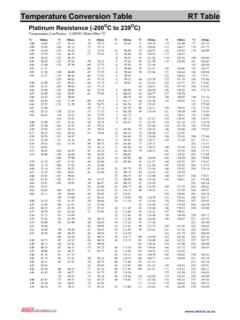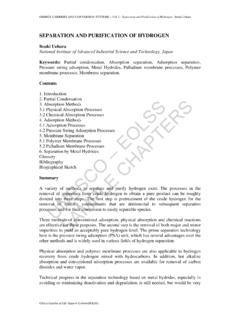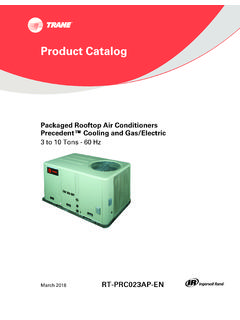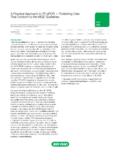Transcription of Performance and Reliability Characteristics of …
1 Performance and Reliability Characteristics of 1200 V, 100 A, 200oC Half-Bridge SiC MOSFET-JBS Diode Power ModulesJames D. Scofield and J. Neil Merrett Air Force Research Laboratory 1950 Fifth St WPAFB, OH 45433 937-255-5949 James Richmond and Anant Agarwal CREE, Inc. 4600 Silicon Dr Durham, NC 27703 Scott Leslie Powerex, Inc. 173 Pavilion Lane Youngwood, PA 15697 Abstract A custom multi-chip power module packaging was designed to exploit the electrical and thermal Performance potential of silicon carbide MOSFETs and JBS diodes. The dual thermo-mechanical package design was based on an aggressive 200oC ambient environmental requirement and 1200 V blocking and 100 A conduction ratings. A novel baseplate-free module design minimizes thermal impedance and the associated device junction temperature rise.
2 In addition, the design incorporates a free-floating substrate configuration to minimize thermal expansion coefficient induced stresses between the substrate and case. Details of the module design and materials selection process will be discussed in addition to highlighting deficiencies in current packaging materials technologies when attempting to achieve high thermal cycle life Reliability over an extended temperature range. Keywords: High temperature, SiC power module, SiC MOSFET, Reliability testing. Introduction Increasing emphases on electrical power functionality and energy conservation is driving an increased demand for reliable, efficient, power conversion, drive, and distribution technologies for automotive, aircraft, and consumer product applications.
3 In addition, an increasing number of these power subsystem components would benefit significantly from an extended temperature range capability [1]. The potential volume, weight, design flexibility, and cost advantages of relaxing thermal design constraints is significant. A 150-200oC rated power technology could enable elimination of the cost and complexity of dedicated power electronics coolant loops in hybrid and electric vehicles, as well as facilitate critical weight reductions in more-electric aircraft actuator drive and power conditioning equipment subsystems [2,3,4]. As a leading candidate to provide the Performance required for these applications, silicon carbide (SiC) device technology is approaching the maturity level necessary for practical deployment consideration.
4 In this paper we report on the Performance and initial Reliability Characteristics of recently developed second generation (Gen II) 1200V, 100A, SiC MOSFET/JBS-diode dual-switch power modules. SiC module electrical Characteristics were evaluated at temperatures up to 250 C, and Performance comparisons to equivalently rated IGBT modules were accomplished over the temperature range of 25-150 C. The 200oC temperature rating objective of the SiC modules necessitated an intentional consideration of all aspects of the package design. Although the operational capability of SiC die at these temperatures is well established, reliable functionality is ultimately dependent upon the utilization of appropriate metallurgies, dielectric encapsulants, interconnection schemes, substrate layout, and the minimization of thermal expansion coefficient (CTE) mismatch stresses.
5 High temperature reverse bias (HTRB), power cycling, and ambient (-40 to 250 C) temperature cycling Reliability test results highlight the relative success and of these design considerations, and more International Conference on High Temperature Electronics International Microelectronics & Packaging Society May 2010 Albuquerque, NMimportantly, illustrate material development needs for wide temperature range power applications. Module Design Gen I modules utilized a modified commercial IGBT form factor with polyphenyl sulfide (PPS) case material and 170 W/mK AlN substrates, 221oC eutectic solder, and low CTE (~4 ppm/K) Cu-C baseplate components to satisfy intermediate 150oC heatsink temperature (TSink) Details of the Gen I module design are described in [5].
6 More extensive material analysis and design variations were carried out in order to reach the Gen II temperature goals of 200 C. Figure 1 shows a photograph of a Gen II module with the lid removed. Figure 1. (Above) Photograph of a Gen 2 module design with lid removed and no encapsulation. (Below) Schematic diagram of the module. Figure 2. Cross-section of Gen II module design. Figure 2 shows a cross-section of the Gen II design. A notable change in this design from the Gen I cinfiguration is the absence of a baseplate. Here, the cooling fins are soldered with 95Pb5Sn solder directly to the direct bonded copper of the ceramic substrate. This reduces the thermal resistance from chip to air and eliminates the mechanical stress due to substrate-to-baseplate CTE mismatch.
7 The case material used was the machinable polyimide Torlon , which has a maximum temperature rating of 260 C. Aluminum nitride was chosen as a substrate material because of its high thermal conductivity and its close CTE match to the SiC die (AlN , SiC ppm/K). Electrical Performance Characterization Fabricated Gen II SiC MOSFET phase-leg modules were characterized for static DC electrical Performance metrics. On-state conduction loss measurements were made, at junction temperatures up to 250oC, for drain current (ID) values of 10 to 120 A per dual switch (two 56mm2 MOSFETs). Representative average switch forward voltage (VDS) as a function of ID is shown in Figure 3, with Figure 3.
8 VDS(ID) of the SiC MOSFET modules showing temperature dependence to 250oC. Si IGBT data at 25 and 150oC shown for comparison. , Vcesat (V)Ids, Ice (A)1200V SiC MOSFET vs Si IGBTC onduction Loss ComparisonSiC Gen II 25 CSi IGBT 25 CSiC Gen II 150 CSi IGBT 150 CSiC Gen II 200 CSiC Gen II 250 CInternational Conference on High Temperature Electronics International Microelectronics & Packaging Society May 2010 Albuquerque, NMtemperature parameterizing the family of curves. Also included in the data of Figure 3 are the 25 C and 150 C VCE data taken from equivalently rated 1200 V, 100 A Si IGBT dual modules (CM100DY-24NF) for comparison. The data reflects a significant MOSFET advantage in on-state 100 A conduction losses with VDS values and V lower than corresponding VCE values for the Si IGBT at 25 and 150 C, respectively.
9 At 200 C the SiC module losses increase approximately 19% above their 150 C value at ID=100 A, but are still lower than the IGBT losses would be at 100 A and 25 C. Forward blocking leakage Characteristics (IDSS) for the SiC modules are well represented by the data shown in Figure 4, in which curves for data collected over the 25-250 C Figure 4. Drain-source forward blocking leakage current data for 25-250 C junction temperatures . Data shown for VGS=-10V. temperature range are plotted. The leakage characteristic data shown are for gate biases of VGS= -10V. Module switch leakage data for VGS=0V, over this same temperature range, were found to be nominally 2X 4X higher, due primarily to the threshold voltage temperature dependence, as shown in Figure 5.
10 Threshold voltage for the SiC parallel MOSFET switches is defined as the gate bias required to induce 10 mA of drain current with 10 V across the device. Although SiC MOSFET leakage Characteristics are several orders of magnitude lower than Si IGBT values at 150 C, and comparable at 25 C, negative gate biases were utilized in HTRB accelerated stress Reliability testing to minimize nuisance trip-offs and increase module test hours. In addition, reliable dynamic Performance in high dI/dt applications will likely necessitate the use of negative off-state gate biases until fabrication process advances yield improved MOSFET threshold Characteristics . Dynamic measurements and characterization of the SiC MOSFET modules parasitic impedances are currently ongoing and will be reported in a subsequent publication.







